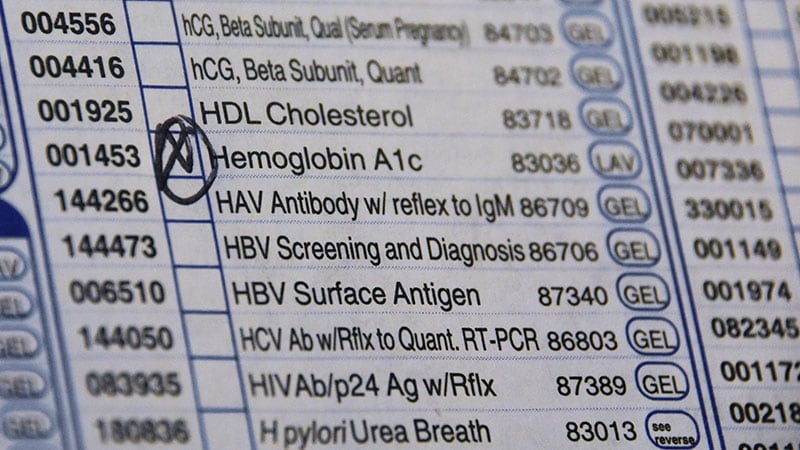A1c Predicts Type 2 Diabetes Risk in Overweight Teens
Core Concepts
A1c levels predict type 2 diabetes risk in overweight and obese adolescents.
Abstract
The content discusses how A1c levels can predict the risk of developing type 2 diabetes in overweight and obese adolescents. It highlights the findings of a study published in JAMA Network Open, focusing on the relationship between A1c levels, obesity, and the incidence of type 2 diabetes. The study population, methodology, and key results are detailed, emphasizing the importance of A1c levels in stratifying the risk of type 2 diabetes in adolescents.
Key Highlights:
- A1c level predicts type 2 diabetes risk in overweight and obese adolescents.
- Study conducted over a 10-year period in a large California healthcare database.
- Risk of type 2 diabetes increases with baseline A1c levels above 6.0% and in severe obesity.
- Study population consisted of 74,552 adolescents aged 10-17 years with overweight or obesity.
- Incidence rates of type 2 diabetes varied by A1c levels, BMI categories, gender, and race/ethnicity.
- Implications for diabetes screening and prevention strategies in adolescents.
Customize Summary
Rewrite with AI
Generate Citations
Translate Source
To Another Language
Generate MindMap
from source content
Visit Source
www.medscape.com
A1c Helps Stratify Type 2 Diabetes Risk in Teens
Stats
"The overall incidence rate of type 2 diabetes during the follow-up was 2.1 per 1000 person-years."
"The incidence rates were higher in female than in male adolescents (2.4 vs 1.8 per 1000 person-years)."
"Compared to baseline A1c below 5.5%, increased risk was ninefold for A1c 5.9%-6.0%, 23-fold for 6.1%-6.2%, and 72-fold for 6.3%-6.4%."
Quotes
"This is the largest and cleanest data set used to assess HbA1c and obesity as predictors of incident diabetes." - Megan Moriarty Kelsey, MD
"Hispanic ethnicity and Black race do not independently predict diabetes, even though diabetes is more common in these populations." - Megan Moriarty Kelsey, MD
Key Insights Distilled From
by Miriam E. Tu... at www.medscape.com 01-17-2024
https://www.medscape.com/viewarticle/a1c-helps-stratify-type-2-diabetes-risk-teens-2024a100013p
Deeper Inquiries
How can the findings of this study impact current diabetes screening guidelines for adolescents?
The findings of this study suggest that A1c levels can be a strong predictor of type 2 diabetes risk in adolescents with overweight or obesity. The study indicates that adolescents with baseline A1c levels above 6.0% are at an increased risk of developing type 2 diabetes. This information can have significant implications for current diabetes screening guidelines for adolescents. Specifically, the study highlights the importance of considering A1c levels in addition to traditional risk factors such as BMI and family history when screening for type 2 diabetes in this population.
Given that adolescents with lower A1c levels in the prediabetes range had a very low incidence of type 2 diabetes, it may be beneficial to reconsider the threshold for diagnosing prediabetes in youth. The study suggests that adolescents with A1c levels in the lower end of the prediabetes range (5.7%-5.8%) may not need to be screened annually as currently recommended by the ADA. Healthcare providers may need to adjust their screening protocols to focus more on those with higher A1c levels who are at greater risk of developing type 2 diabetes.
What are the implications of the study's results for healthcare providers working with overweight and obese youth?
The study's results have several implications for healthcare providers working with overweight and obese youth. Firstly, the findings underscore the importance of considering A1c levels as a predictive factor for type 2 diabetes risk in this population. Healthcare providers should be aware that adolescents with higher A1c levels, more severe obesity, female gender, and certain racial or ethnic backgrounds, such as Asian or Pacific Islander, may be at an increased risk of developing type 2 diabetes.
Healthcare providers should also take into account the study's suggestion that adolescents with lower A1c levels in the prediabetes range have a very low incidence of type 2 diabetes. This information can help providers prioritize interventions for those at higher risk while potentially reducing unnecessary screening for those at lower risk. Additionally, the study highlights the importance of monitoring changes in weight and BMI over time, as these factors can influence the risk of type 2 diabetes in overweight and obese youth.
How can socioeconomic factors influence the risk of type 2 diabetes in adolescents?
Socioeconomic factors can play a significant role in influencing the risk of type 2 diabetes in adolescents. The study's findings indicate that race and ethnicity can impact the incidence of type 2 diabetes, with differences observed among different racial and ethnic groups. For example, the study found that Asian or Pacific Islander adolescents had a higher incidence of type 2 diabetes compared to White adolescents.
Additionally, socioeconomic factors such as access to healthcare, quality of care, and environmental influences can also contribute to the risk of type 2 diabetes in adolescents. Adolescents from lower socioeconomic backgrounds may face barriers to accessing healthcare services, including diabetes screening and management. Limited access to healthy food options, safe places for physical activity, and education about healthy lifestyle choices can also increase the risk of type 2 diabetes in this population.
Healthcare providers working with adolescents at risk for type 2 diabetes should consider the impact of socioeconomic factors on their patients' health outcomes and tailor interventions to address these disparities. Collaborating with community resources, providing education on healthy behaviors, and offering support for lifestyle changes can help mitigate the influence of socioeconomic factors on the risk of type 2 diabetes in adolescents.
0
